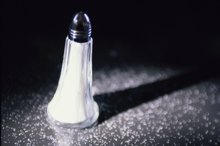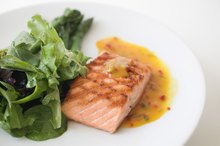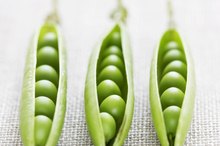What does fact checked mean?
At Healthfully, we strive to deliver objective content that is accurate and up-to-date. Our team periodically reviews articles in order to ensure content quality. The sources cited below consist of evidence from peer-reviewed journals, prominent medical organizations, academic associations, and government data.
The information contained on this site is for informational purposes only, and should not be used as a substitute for the advice of a professional health care provider. Please check with the appropriate physician regarding health questions and concerns. Although we strive to deliver accurate and up-to-date information, no guarantee to that effect is made.
Foods That Cause Dark Circles
Dark circles under your eyes are generally symmetrical and accompanied by swelling 123. These circles are found on men, women and children and are caused by multiple factors, including heredity and age. Although these factors are out of your hands, some factors that lead to dark circles—such as diet—are not 24. Foods cannot be a complete cure or culprit, but cutting out foods that contribute to your dark circles might help in reducing their appearance 24.
Exhaustion and Caffeine-Rich Foods
Exhaustion is another cause of dark circles 24. Exhaustion can cause your skin to become pale, which makes the blood vessels underneath the thin skin underneath your eyes more visible. If you drink too much caffeine, it might cause exhaustion because of stimulation of your hormonal glands, says the Caring Medical website. Diet sodas are also to be avoided, as the aspartame contained in the soft drink can cause exhaustion in the long-term, the site says. To remedy this, try swapping sodas and other caffeine-filled products such as coffee, black tea and chocolate for water or non-caffeinated teas 2.
Sodium- and Potassium-Rich Foods
Dieting Causes Nausea & Visual Disturbances
Learn More
Sodium, in excess, can cause the swelling accompanied by dark circles 24. This is because sodium, which salt contains, causes water retention in the body, including the area around your eyes. Consume only moderate amounts of salt to help reduce the puffiness around your eyes. This holds true for potassium as well. Potassium, in moderate amounts, might help eliminate the puffiness that sodium lends to your dark circles 24. However, in excessive amounts, potassium can actually cause the circles. High-potassium foods include turkey, soybeans, peanut butter, yogurt and milk. Oranges, tomatoes and sweet potatoes also have high levels.
- Sodium, in excess, can cause the swelling accompanied by dark circles 2.
- However, in excessive amounts, potassium can actually cause the circles.
Allergy-Causing Foods
Dark circles might a sign that you are experiencing sensitivity or an allergic reaction to a certain food 24. The foods that cause:
- these reactions range from person to person
- but some of the most allergenic foods are chocolate
- peas
- yeast
- citrus fruits
- mustard
- sugar
- says the Ask Dr
Sears website. Try trading a highly allergenic food for less allergenic foods, such as
- apples
- lettuce
- grapes
- rice
- broccoli
- honey
Related Articles
References
- Mayo Clinic: Dark Circles under Eyes
- Dark Circles: Remedy for Dark Circles
- Caring Medical: Dark Circles Around Your Eyes
- Food Scout: Dark Circles
- Sarkar R, Ranjan R, Garg S, Garg VK, Sonthalia S, Bansal S. Periorbital hyperpigmentation: A comprehensive review. J Clin Aesthet Dermatol. 2016;9(1):49–55.
- Ahmadraji, Fatemeh & Shatalebi, Mohammad. (2015). Evaluation of the clinical efficacy and safety of an eye counter pad containing caffeine and vitamin K in emulsified Emu oil base. Advanced biomedical research. 4. doi: 10.10.4103/2277-9175.148292.
- Sarkar R, Ranjan R, Garg S, Garg VK, Sonthalia S, Bansal S. Periorbital hyperpigmentation: A comprehensive review. J Clin Aesthet Dermatol. 2016;9(1):49–55.
- Vrcek I, Ozgur O, Nakra T. Infraorbital dark circles: A review of the pathogenesis, evaluation and treatment. J Cutan Aesthet Surg. 2016;9(2):65–72. doi:10.4103/0974-2077.184046
- American College of Allergy, Asthma, and Immunology. What are allergic shiners?
- Mukherjee, Pulok & Nema, Neelesh & Maity, Niladri & Sarkar, Birendra. (2012). Phytochemical and therapeutic potential of cucumber. Fitoterapia. 84. 10.1016/j.fitote.2012.10.003
- Marini A, Grether-beck S, Jaenicke T, et al. Pycnogenol® effects on skin elasticity and hydration coincide with increased gene expressions of collagen type I and hyaluronic acid synthase in women. Skin Pharmacol Physiol. 2012;25(2):86-92. doi:10.1159/000335261
- Ahmadraji, Fatemeh & Shatalebi, Mohammad. (2015). Evaluation of the clinical efficacy and safety of an eye counter pad containing caffeine and vitamin K in emulsified Emu oil base. Advanced biomedical research. 4. doi: 10.10.4103/2277-9175.148292.
Writer Bio
Sarah Thompson has been a writer since 2006. She has contributed to Ohio-based publications such as "CityScene" and "Dublin Life" magazines, as well as Columbus' top alternative weekly, "The Other Paper." Thompson has also written for several online outlets, including Smashing Magazine and Web Designer Depot. She holds a Bachelor of Arts in journalism, sexuality studies and visual communication design from Ohio State University.









